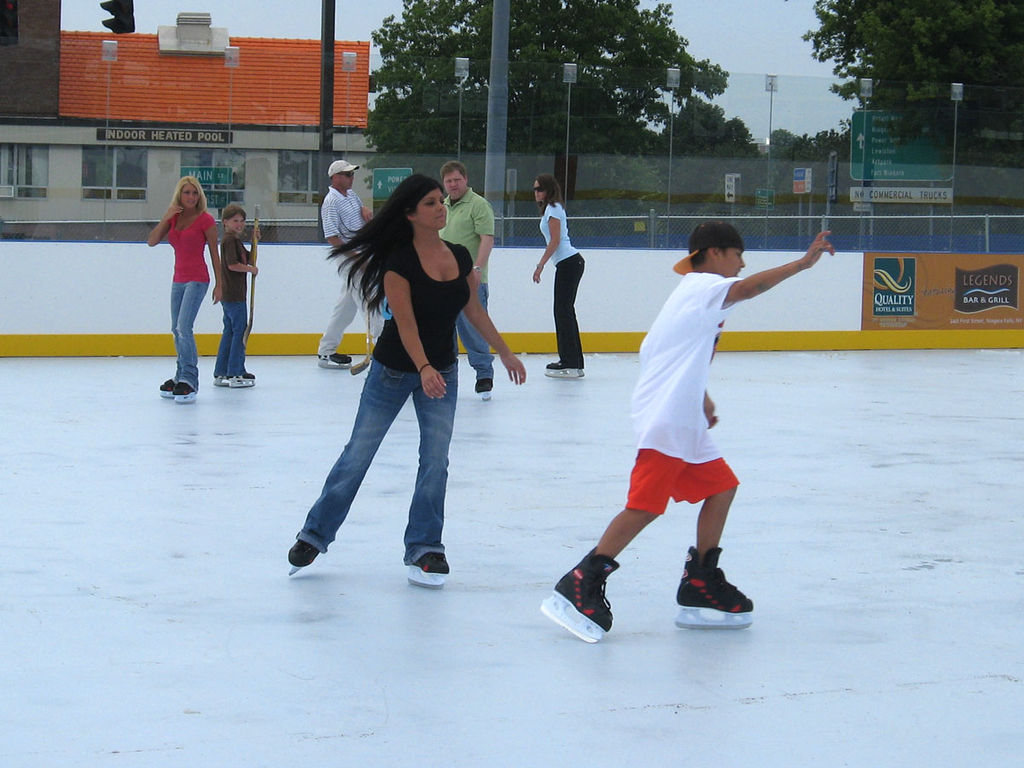Getting hockey practice during off-seasons can be more than a little tough. It’s even tougher if you don’t live somewhere where ice naturally forms. Of course, you could go to an ice skating rink, but these rinks usually aren’t great for hockey unless they have specific hockey training times.
Between the people that are at the skating rink for fun and the fact that there are often small children there, things can get complicated really quickly when you’re trying to get hockey practice. That’s where having a synthetic ice rink comes in. Truly a way that you could get practice in your own backyard.
If you’re looking at some artificial ice, or you already have some, you might have a few questions. For example, what is this ice made out of, how do you install it, the list goes on. There’s a lot to know about this kind of ice before you get started, which makes things a little tricky as an artificial ice owner.
That’s why we’ve written today’s article. We’re hoping to teach you all of this and more so you can feel more confident about your level of knowledge about artificial ice in general. Hopefully, by the time we’re done here, you’ll be able to get your synthetic ice rink set up like a pro.
What is the Difference Between Artificial Ice and Real Ice?
When we think of ice, the first thing that comes to mind is probably a quart-sized block of the frozen stuff in our freezer. But what about artificial ice? What’s the difference between artificial and real ice? These are all fantastic questions and things that we fully intend to address in this section.
Let’s begin with looking at real ice. You’re probably familiar with it as it’s pretty much everywhere. In your freezer, on the road in some parts of the country during winter months, sometimes whole lakes turn to ice, and sometimes the rain even freezes and comes down in the form of hail, which is just chunks of ice.
Real ice is the more straightforward part of this formula. It’s just water that has been cooled to at least 32 degrees Farenheight, or 0 degrees Celsius. Pressure ice is also a thing, but it’s not as common on our planet as it is on other planets throughout the universe.
Artificial ice is a bit of a confusing term because a lot of people hear it and think that we’re referring to artificially frozen ice. That is not the case. The artificial ice that we’re talking about is actually a series of interlocking tiles that are made up of special types of plastic.
This plastic is very chemically complicated, but essentially the kinds of plastic that are chosen are used because of their glide factor. No synthetic ice has as good of a glide factor as true ice, but some of them do get pretty close to the point that some people can’t even tell the difference.
As you’re probably aware, true ice has been around for about as long as the earth has been around. The earliest form of this type of artificial ice was invented in the U.K. in the late 1800s, but it didn’t get the level of success that it knows today until the mid-1900s.
That’s largely because of the invention of the game of hockey. Hockey players have the biggest reasons to use artificial ice, while other people would really only want or need to use artificial ice for the novelty of having the ability to ice skate when things are warmer out.
How to Install Your Synthetic Ice Rink
Getting your synthetic ice skating rink set up in your home is very fun and exciting, but there are some things you need to know in order to be sure that you’re setting it up correctly. This is an easy process, but it’s also pretty easy to do wrong if you don’t know what you’re doing.
Let’s start with the steps you would need to take before you place your order so you can be sure that you have everything done correctly.
- Pick out the space you want to use for your artificial ice rink.
- Measure the space and write down your measurements.
- Determine how many tiles you’ll need to order.
- This is usually pretty simple. If each tile is 1 square foot and you have 100 square feet you need to fill, you’d need 100 tiles.
- Place your order online or pick up the tiles from the store.
- Get enough plywood to use as a foundation for the tiles.
These first five steps are simple, and you can even reverse steps 4 and 5. We’d recommend against switching any of the other steps, especially ordering before you measure. If you do that then you could either end up with too many tiles or too few tiles, and both of those are less than ideal.
So, what do you do once you actually have your tiles in hand and you’re ready to get things set up? It’s pretty simple and your tiles should come with some documentation to help you with this, but let’s look at the steps here just in case that didn’t happen or you’re just looking to get a feel for the process before you actually spend any money:

- Mark out the space that you want to use for the artificial ice skating rink.
- You could use a variety of household objects for this, including:
- Painter’s tape.
- Chairs.
- Towels.
- Cones.
- Moving boxes
- Books.
- DVD cases.
- Assorted cans.
- Etc.
- Lay out your plywood to act as a base for the rink.
- The plywood doesn’t have to be one single sheet, but do be careful that the seams of the plywood don’t line up with the seams of the tiles to ensure maximum stability.
- Take the tiles out of their packaging.
- Start interlocking the tiles in whatever fashion you prefer.
- There are a few ways to do this, but the two methods we recommend most are the:
- Jigsaw puzzle method, where you work on the edges and then circle your way in until you’re done.
- Typewriter method, where you go from left to right (or visa versa) from top to bottom until all the pieces are connected.
- Finish connecting all of the tiles.
- Inspect the rink to make sure that everything is aligned correctly to lessen the risk of accidental injuries.
Once you’ve finally gotten all of the tiles lined up properly, you’re done and ready to skate on your new artificial ice skating rink. Or, to have your children or other family members start skating on the ice skating rink.
Depending on the quality of the tiles that you got, you probably won’t have to move the tiles unless you want to. High-quality tiles are designed to stand up to even the harshest weather conditions, so even if it’s going to be raining buckets or 112 degrees outside, your tiles can stay right where they are.
How Long Does This Process Take?
Time is money, and the more time you have to spend on this project the more time you won’t be able to spend doing other things you enjoy, like getting in some much-needed hockey training. So, a big question that we get is “how long will this take?”
This question might be a little more complicated than it seems on the surface because of how flexible the sizing of these artificial ice skating rinks are. You could feasibly fit them anywhere you need, regardless of if you have 10 square feet or 10,000 to work with.
Obviously, the smaller the area is the less time it will take to get set up. The low side of the average side of this kind of project is about 250 square feet, or about the size of a one-car garage. Assuming that the tiles you’re working with are 1 square foot, you’d need to put down 250 tiles. That should only take a couple of hours if you work fast.
The bigger the area is the more time it will take, so if you’re going for 1000 square feet it will take you about 4 times longer than the 250 square feet. The good news about this is that the labor here is a lot more repetitive than difficult.
That means that there’s a good chance that you could bribe your friends to come to help you with pizza and beers, even if you and all of your friends are clear over 30. You could even make a game of it to make it that much more fun.
Getting Your Practice Space Set Up Right
There are a lot of things that people trying to train to be better hockey players do, and getting the right artificial ice for your house can make your at-home skating rink that much nicer. Knowing that you can get some on the ice training any day of the week without ever leaving your home is definitely a luxury that every hockey player deserves.




